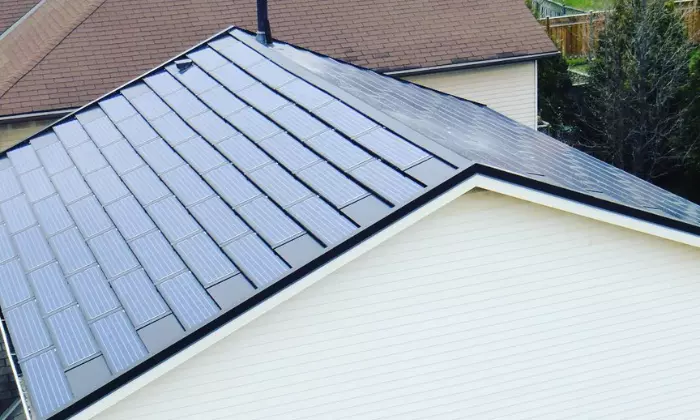What are Solar Shingles?
Solar shingles, or solar roof tiles, are thin photovoltaic (PV) sheets that can be put on top of or in place of roof shingles. They take in light from the sun and turn it into power. If homeowners use this energy source instead of electricity, they will save money on their monthly bills and finally get their money back.
Solar shingles, like regular roof tiles, keep your home safe from the weather and other things that can damage it. These shingles save energy and make a house look better than the big, bulky panels that are usually associated with solar power.
Types of Solar Shingles

Two main photovoltaic shingles for household solar power are silicon solar cells and CIGS thin-film photovoltaics.
Silicone Solar Shingles
Silicon shingles resemble solar panels. They are rigid and in a frame, thin, and proportional to regular roofing materials, and installed with them.
CIGS Solar Shingles
CIGS photovoltaic roof shingles generate household solar power using the latest thin film technology. CIGS shingles are lighter and more flexible, blending with existing or new roofs.
How Do Shingles Work?
Shingles are smaller and thinner versions of regular photovoltaic (PV) solar panels. These shingles utilize crystallized silicon as a conductive material to create solar cells, which transform solar energy into electricity. The generated electricity is then directed to an inverter, where it is conditioned into alternating current (AC) electricity. Subsequently, the AC electricity is sent to a distribution panel for utilization within the building.
Cost Of Solar Tiles
Solar tiles can eliminate the need for separate expenditures on a new roof and a solar system. If you require a roof replacement, you can install solar tiles instead of regular shingles and a different PV solar system. However, in most scenarios, shingles are generally more expensive than regular solar panels. While some solar and roofing companies may claim that shingles are comparable in cost to solar systems and new roofs, premium options like Tesla’s solar roof can come at a significantly higher price. It’s worth noting that solar panels can be installed on an existing roof in good condition, not necessarily need replacement.
Solar Investment Tax Credit
In many cases, you can take advantage of the federal government’s 30% solar investment tax credit for the solar component of your roofing system. However, it’s important to note that this tax credit may not cover certain expenses related to roofing. The solar investment tax credit has been a popular means of reducing the cost of various solar installations, allowing you to recoup 30% of the installation costs in the year the system is put into service.
Disadvantages
Because they are put on instead of regular shingles, solar shingles depend on the direction of your roof. Roofs are only sometimes built to get the most sunlight or photovoltaic efficiency, which can make your rooftop solar system produce less power. Increasing the size of the area that solar shingles cover can compensate for this inefficiency. Unfortunately, more coverage means more cost and less improvement in how things look. Solar panels on roofs can be tilted and directed to get the most out of the sun’s energy. This means that they can cover a smaller area but make more electricity.
Efficiency Considerations
Most solar roof products have an efficiency range of 11% to 16%. In comparison, solar panels have an average efficiency of approximately 18%, with high-quality panels reaching over 20% and the most efficient widely available panel achieving 22.8% efficiency. Efficiency is crucial because it directly impacts the amount of free electricity your system can generate.
Less efficient panels or shingles require more roof space to produce the same amount of electricity. Additionally, shingles face a disadvantage in electricity production due to their direct installation against the roof sheathing, which restricts airflow around the solar cells. This limitation leads to higher temperatures, lower efficiencies, and reduced production. In contrast, traditional rooftop panels are mounted on a racking system, creating a small gap, allowing airflow, cooling the panels, and improving efficiency and production.
Longevity and Maintenance of Solar Roofs
Most shingles come with a manufacturer’s 20 to 25-year warranty, aligning with the warranties offered for solar panels, which typically range from 20 to 30 years. However, maintaining a solar roof poses an ongoing challenge. While individual solar panels can be easily replaced in the event of a failure, replacing a failed part of a solar roof would be more complex due to the interlocking installation. Addressing a single shingle issue might require removing an entire section of panels.
Solar Shingles vs. Solar Panels
Choosing between solar shingles and solar panels depends on your priorities. Shingles integrate with roofing materials, creating an aesthetically pleasing appearance. However, if you need to replace your roof and have the financial means, installing solar power shingles can be a feasible option, costing approximately the same as replacing your roof and adding a solar system. On the other hand, if your roof is in good condition and you aim to maximize cost savings, residential solar panels are a better choice. They offer higher efficiency, generating more free electricity within the same space. While solar systems come in various colors and designs, solar shingles may blend in differently than they are.
At Solar Earth Inc we provide Solar panels to our customers with the best price, production, and durability combination. We continuously explore new products to ensure that we offer the most advanced and suitable solutions available.
Contact your local solar provider today!
Solar Earth Inc., with expertise and certifications, empowers your home for enhanced energy generation. Contact us today to transform your home into a sustainable, long-term renewable energy source.
Get a free quote or Call at (805) 691-8000
